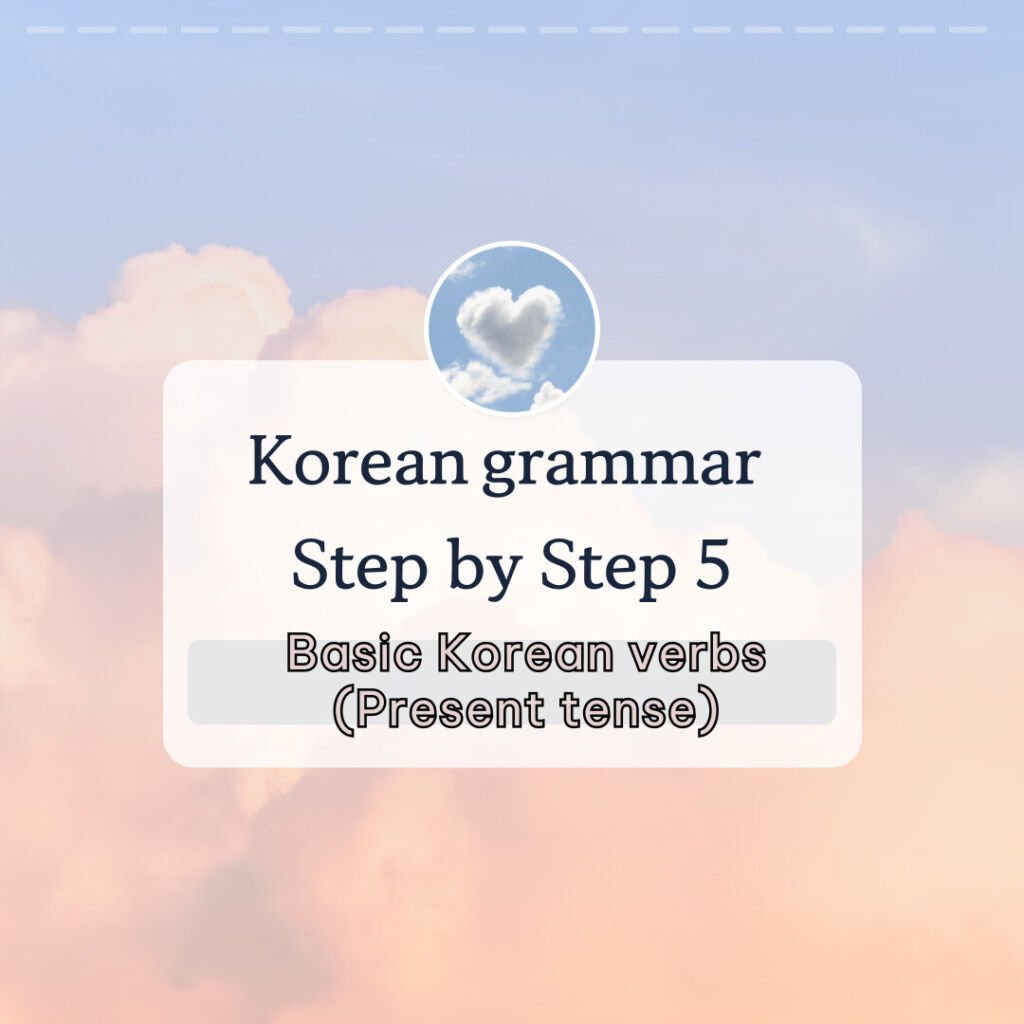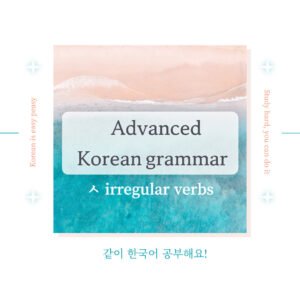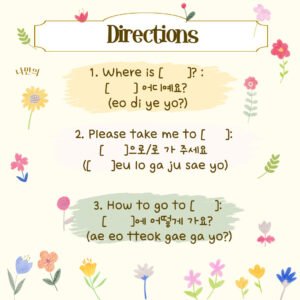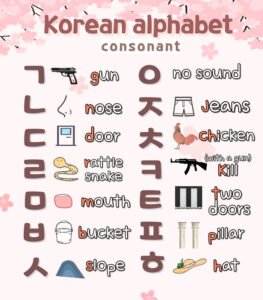Basic Korean Verbs (Present Tense) : Master Korean Grammar Step by Step #5
Hello, welcome to our 5th step of your Korean journey!
Today we will master basic Korean verbs and present tense conjugations!
First, let’s take a look at basic verb forms in Korean.
Every verb and adjective in Korean ends in “다” . This is the original form!
And we will conjugate (change the verb form) depending on the tense and formality.
Part 1,
Let’s grasp the concept of grammar
Basic Korean verbs and present tense conjugations
Here are 10 basic Korean verbs to get us started:
| 보다 | to see, watch |
| 먹다 | to eat |
| 살다 | to live |
| 자다 | to sleep |
| 가다 | to go |
| 읽다 | to read |
| 배우다 | to learn |
| 좋아하다 | to like |
| 일하다 | to work |
| 공부하다 | to study |
Everything ends in 다. Right?!
Now, we will conjugate(change) the verbs. It’s like playing a little game!
What we are going to do is find certain vowels (ㅏ, ㅗ ).
Let’s look at this verb: 살다 (to live)
First, we will remove the ending 다, leaving us with “살” (we will call this a verb stem!)
Here, the verb stem’s vowel is ㅏ, right?
If the vowel is eitherㅏ or ㅗ, we will add 아요.
So, It becomes 살아요.
Now, let’s look at this verb: 먹다 (to eat)
First, we will remove the ending 다, leaving us with the verb stem “먹”
Here, the verb stem’s vowel is ㅓ, right?
If the vowel is not eitherㅏ or ㅗ, we will add 어요.
So, It becomes 먹어요.
Last one is any verbs ending in 하다
If a verb ends in 하다, like 공부하다(to study), 일하다(to work)
We will change 하다 to 해요.
공부해요. 일해요
Conjugation Steps for Verbs in present tense
- Remove “다” (da) from the original form to get the verb stem.
- Add “아요” if the last vowel in the stem is “ㅏ” (a) or “ㅗ” (o).
- Add “어요” for all other vowels.
- If a verb ends in “하다”, replace “하다” with “해요“
This 아요/어요/해요 is the most common, fairly formal conjugation in present tense.
| 먹다 | To eat (original form) |
| 먹습니다 | extremely formal |
| 먹어요 | fairly formal, most common |
| 먹어 | informal |
From “먹다 (to eat)”, if you add the ending “습니다”, it becomes very formal: “먹습니다”.
If you add “어요”, it becomes the most commonly used formality: “먹어요”.
Removing the “요” part makes it informal: “먹어”.
Now, let’s practice with more verbs. But before we get into that, I’ll quickly introduce a new particle for objects. In Korean, we have two particles “을” and “를”, which indicates the object in a sentence.
We use “을” if the object ends in a batchim(final consonant), and “를” if the object ends in a vowel.
Ex) 나는 바나나를 먹어요. (I eat bananas). 바나나 ends in a vowel, we use “를”
너는 빵을 먹어요.(You eat bread). 빵 ends in a batchim(ㅇ), we use “을”
Now, let’s conjugate and practice with more verbs!
1. 보다(to see)
– Removing the ending “다”, leaving us the verb stem with “보”
– Since it contains the vowel ” ㅗ”, we will add 아요. (for the vowels ㅏ,ㅗ)
– Now we get “보아요”.
– Here’s the thing! we have a double vowel formed by the combination of “ㅗ + ㅏ”, which becomes “ㅘ”. So, here we contract the vowels, and 보아요 becomes 봐요!
Example
– 나는 유투브를 봐요. (I watch Youtube)
– 우리 남동생은 티비를 봐요. (My younger brother watches TV)
2. 자다(to sleep)
– Removing the ending “다”, leaving us with the verb stem “자”
– Since it contains the vowel “ㅏ”, we will add 아요. (for the vowels ㅏ,ㅗ)
– Now we get “자아요”.
– Here’s the thing! we have a double “ㅏ” vowel sound, so we’ll get rid of one of them.
By removing one “아” , 자아요 becomes 자요!
Example
– 우리 아빠는 지금 자요. (My dad sleeps now)
3. 가다(to go)
– Removing the ending “다”, leaving us with “가”
– Since it contains the vowel “ㅏ”, we will add 아요. (for the vowels ㅏ,ㅗ)
– Now we get “가아요”.
– Same! we have a double “ㅏ” vowel sound, so we’ll get rid of one of them.
By removing one “아” , 가아요 becomes 가요!
Example
– 지금 집에 가요. (I go home now)
– 학교에 가요 (I go to school)
*When talking about a destination, to indicate the “to” part in English, we use the particle “에” in Korean.
If you don’t remember the usage of “에”, check out my previous post!
4. 읽다(to read)
– Removing the ending “다”, leaving us with “읽”
– Since it contains the vowel ” l “, we will add 어요. (since it is not “ㅏ” or “ㅗ”)
– Now we get “읽어요“.
Example
– 해리포터 책을 읽어요 (I read harry potter books)
– 뉴스를 읽어요 (I read news)
5. 배우다(to learn)
– Removing the ending “다”, leaving us with “배우”
– We will look at the last part (우); its vowel is “ㅜ”, we will add 어요. (since it is not “ㅏ” or “ㅗ”)
– Now we get “배우어요”.
– Here, we have a double vowel formed by the combination of “ㅜ + ㅓ”, which becomes “ㅝ”.
We’ll contract the vowels, so “배우어요” becomes “배워요”
Example
– 한국어를 배워요 (I learn Korean)
– 한국 역사를 배워요 (I learn Korean history)
6. 좋아하다(to like)
– 좋아하다 ends in 하다, so we will simply replace 하다 with 해요.
– It becomes “좋아해요”
Example
– BTS를 좋아해요 (I like BTS)
– 한국 문화를 좋아해요 (I like Korean culture)
7. 일하다(to work)
– 일하다 ends in 하다, so we will simply replace 하다 with 해요.
– It becomes “일해요”
Example
– 우리 부모님은 매일 일해요 (My parents work everyday)
– 한국 사람들은 많이 일해요 (Koreans work a lot)
8. 공부하다(to study)
– 공부하다 ends in 하다, so we will simply replace 하다 with 해요.
– It becomes “공부해요”
Example
– 나는 매일 한국어 공부해요 (I study Korean everyday)
– 인도 사람들은 많이 공부해요 (Indians study a lot)
In Korean, the verb 하다 means “to do“. Many verbs that end in 하다 are combinations of nouns and the verb 하다, which essentially means “to do” that noun. This structure allows you to create a variety of verbs by pairing 하다 with different nouns.
For instance, 공부하다 = 공부 (study) + 하다 (to do) → do studying → to study
일하다 = 일 (work) + 하다 (to do) → do work → to work
운동하다 = 운동 (exercise) + 하다 (to do) → do exercise → to exercise
While many 하다 verbs are formed by combining nouns with 하다 (to do), there are important exceptions to this rule, especially with adjectives and verbs related to emotions or feelings.
For example, 좋아하다 (to like) is not a combination of a noun and 하다, since it’s related to your feelings.
Understanding these exceptions is crucial, particularly when forming negative sentences. We will revisit this concept when we cover how to negate sentences!
Let’s take a quick quiz! Conjugate the verbs
1. 오다 (to come)
(1) 오아요
(2) 오어요
(3) 오해요
(4) 와요
2. 만들다 (to make)
(1) 만들어요
(2) 만들아요
(3) 만들해요
(4) 만들워요
3. 놀다 (to hang out)
(1) 놀어요
(2) 놀아요
(3) 놀해요
(4) 놀와요
4. 청소하다 (to clean)
(1) 청소어요
(2) 청소아요
(3) 청소해요
(4) 청소워요
5. 쉬다 (to rest)
(1) 쉬어요
(2) 쉬아요
(3) 쉬해요
(4) 쉬와요
These are the answers:
1 – (4) 와요
[오다: The verb stem “오” has the vowel “ㅗ”, so we conjugate it with “아요”.
This gives us “오아요”. Then, we contract the two vowels, and it becomes “와요”.]
2 – (1) 만들어요
[만들다: The verb stem “들” has the vowel “ㅡ”, so we conjugate it with “어요”. This gives us “만들어요”.]
3 – (2) 놀아요
[놀다: The verb stem “놀” has the vowel “ㅗ”, so we conjugate it with “아요”. This gives us “놀아요”.]
4 – (3) 청소해요
[청소하다: The verb ends in “하다” , we replace it with “해요”]
5 – (1) 쉬어요
[쉬다: The verb stem “쉬” has the vowel “ㅟ”, so we conjugate it with “어요”. This gives us “쉬어요”.]
Great job, well done!
Now let’s practice forming slightly more complicated sentences.
By doing this together, you will become more familiar with the usage of particles and sentence order.
So don’t skip this part and try these on your own as well!






